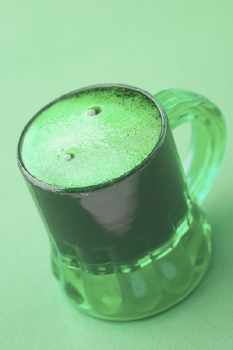Mar 15 2005
 A standard drink is generally calculated as a 12-ounce glass of beer, four-ounce glass of wine, or one-ounce shot of hard liquor. These measures do not allow for differences in alcohol content within beverage categories, such as malt liquor beers (MLBs), which have a higher alcohol content by volume compared to other beers, are typically sold in larger containers, and are priced lower by volume. MLBs have also historically been targeted at lower-income, minority communities.
A standard drink is generally calculated as a 12-ounce glass of beer, four-ounce glass of wine, or one-ounce shot of hard liquor. These measures do not allow for differences in alcohol content within beverage categories, such as malt liquor beers (MLBs), which have a higher alcohol content by volume compared to other beers, are typically sold in larger containers, and are priced lower by volume. MLBs have also historically been targeted at lower-income, minority communities.
A study in the March issue of Alcoholism: Clinical & Experimental Research has found that MLB drinkers are more likely to be homeless, unemployed, receive public assistance, and tend to drink more alcohol, more often, than other types of drinkers.
"Measuring MLB consumption is difficult because MLBs differ from other beer beverages in two important aspects: container size and alcohol content by volume," said Ricky Bluthenthal, assistant professor at Charles R. Drew University of Medicine and Science and corresponding author for the study. "We found that the combination of these differences resulted in the average malt liquor drinker in our study consuming 80 percent more alcohol per drink than the average regular beer drinker. Although we did not report consequences in this paper, typically the more alcohol consumed the greater the probability of negative alcohol-related consequences for an individual and their community."
"MLBs can be sold in containers as large as 40-ounce bottles, or 'forties' as they are referred to," said Rhonda Jones-Webb, associate professor in the School of Public Health at the University of Minnesota. "'Forties' are commonly sold chilled and wrapped in brown paper bags for immediate consumption, and independent web sites devoted to malt liquor as well as rap lyrics and movie scripts encourage 'chugging' the bottles before they get warm. The combined effects of higher alcohol content, larger serving size, and faster consumption can result in higher blood alcohol levels, an increased risk of aggressive behavior, and other alcohol-related problems."
Jones-Webb added that MLBs are largely targeted to African American and Hispanic youth, and young adults. "Malt liquor brands such as Steel Reserve, Hurricane, Magnum, and Panther are used by the alcohol industry to connote power and machismo and lure youth and young adults into the market. Rap artists have been popular images in malt liquor advertising and 'gangsta' rap performers portray malt liquor as a sign of masculinity. The targeting of minority youth for malt liquor sales is of particular concern because alcohol advertising has been shown to influence brand choice, and brand choices during youth can influence beverage choices as adults."
For this study, researchers conducted face-to-face interviews with 329 drinkers recruited from randomly selected alcohol outlets in south Los Angeles, gathering information on items that included socio-demographic characteristics, alcohol-use history, drinking patterns, and drinking context.
"Based on previous research," said Bluthenthal, "we know that MLBs because of price per volume and availability are likely to be more attractive to lower-income drinkers. In addition, advertising and popular culture references to MLBs are more prevalent in media that is likely to be seen or used by African Americans. In short, south Los Angeles seemed to fit the profile we needed."
The sub-sample that reported drinking in the previous 90 days (n=297) was 88 percent African American, 72 percent male, and 35 percent unemployed. Compared to regular beer and hard-liquor consumers, MLB drinkers were more likely to be homeless, receive public assistance for housing, and not be employed; MLB drinkers reported significantly higher rates of daily or near daily drinking, drinks per day on drinking days, and daily average alcohol consumption; MLB drinkers were also more likely to smoke while drinking, drink with same-sex friends, and drink outdoors.
'The drinking levels we observed among MLB consumers were on average higher than the amount of alcohol consumed by individuals who are entering alcohol treatment programs," said Bluthenthal. "The study also confirms that MLBs are consumed in potentially more hazardous amounts and settings than regular beers, and that grouping MLB drinkers with regular beer drinkers is likely to result in underestimates of alcohol consumed among MLB drinkers as well as the consequences of this consumption."
"Future research should focus on malt-liquor consumption across racial/ethnic groups, how it may vary, and how it may contribute to disparities in alcohol-related problems among these groups," said Jones-Webb. "For this we will need large samples of African American, Hispanic, Asian, and American Indian populations. Ethnographic studies are also needed to understand the meaning of malt liquor, the settings and context in which it is consumed, and beliefs regarding its use and consequences. Such studies can complement insights gained from surveys."
Bluthenthal and his colleagues are currently collecting information on alcohol consumption in California and Louisiana by beverage type in order to explore if alcohol drinking patterns and consequences differ for MLB consumers. They will also continue to analyze data from this study, investigating gender differences in drinking behaviors and self-reported alcohol-related consequences.
http://www.umn.edu/